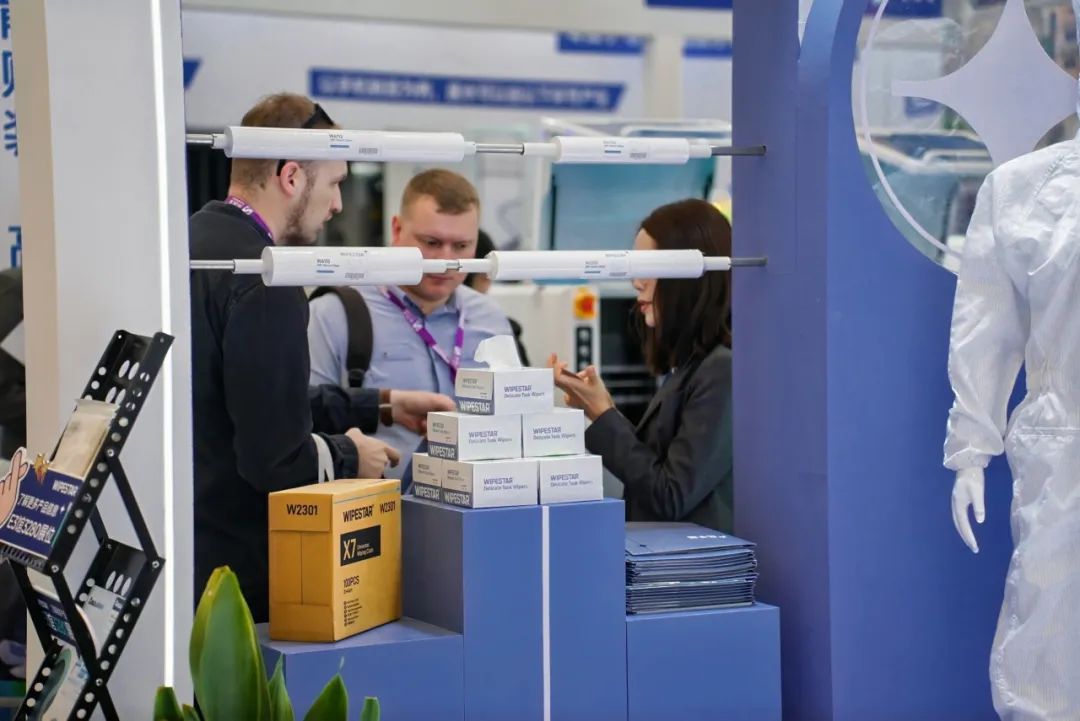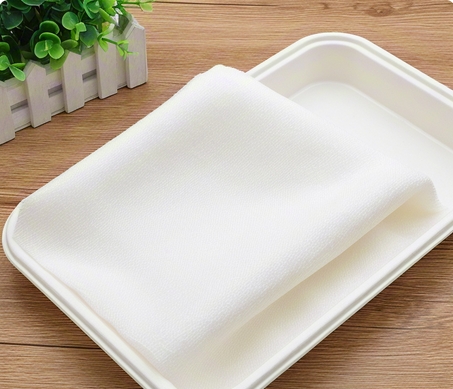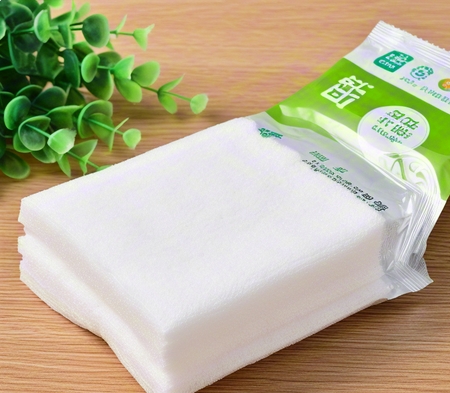Language

In the process of upgrading the precision manufacturing industry, the quality standards of industrial wipes are undergoing systematic reconstruction. A well-known automotive parts supplier once caused abnormal wear of the spindle of the five-axis linked machining center worth RMB 28 million due to the use of non-standard wipes, and the single repair cost exceeded RMB 1.2 million. This typical case confirms the strict requirements of precision equipment for industrial wipes - just like the dustproof system of precision optical instruments, micron-scale impurities may cause systemic risks.
1: The international standard for scientific matching of fiber materials ISO 9073-12 clearly stipulates that the fiber matching of high-quality industrial wipes must be accurate to the error range of ±2%. Taking the CP type (polyester fiber + wood pulp) industrial wipe cloth as an example, the gold ratio of 45% polyester fiber content can achieve double balance: a liquid absorbance of 8.8g/m² and a wear resistance of 3.6N. The biocompatibility wipes used in the medical field must pass the ASTM F2100 standard certification and their cytotoxicity must be controlled at level 0.
Key indicators of mechanical performance In the field of automobile manufacturing, the weight of industrial wipes is usually controlled at 80-120g/m², while semiconductor-grade dust-free cloths require 150-250g/m², which creates a significant technological generation difference. Referring to the GB/T 3923.1 standard, the meridian load of the high-end wipe cloth must bear continuous impact equivalent to 5kg of heavy objects, which is equivalent to the strength of hanging 200 bottles of 500ml of mineral water over an area of 1 square meter.
Chemical tolerance verification Solvent-resistant industrial wipes certified by ISO 105-B02 can maintain 87% original strength in extreme environments with pH values of 1.5-13. Comparative experiments by an aircraft engine manufacturer showed that after using a special acid- and alkali-resistant wipe cloth, the cleaning efficiency of CFM56 turbine blades increased from 62% to 89%, and the assembly time of a single engine was shortened by 35 minutes.
2. Industry customized application practices In the automobile manufacturing industry, special wipes that comply with VDA 19.3 standards must ensure that no more than 1,800 particles per square meter >5μm are allowed. The actual data of a new energy vehicle battery module production line shows that the use of a standard-compliant wipe cloth can reduce the detection rate of foreign objects on the surface of the battery cell to below 0.3ppm. In contrast, the semiconductor wafer manufacturing process has more stringent requirements on the wipe cloth and needs to meet the 0.1μm-level particle control requirements in the IEST-STD-CC1246D standard.
It is worth noting that in the field of precision optical component cleaning, anti-static industrial wipes need to stabilize the surface resistance in the range of 10^6-10^8Ω. A yield increase report from a certain LCD panel manufacturer pointed out that after adopting standard anti-static cloth, the failure rate of panel line short circuit dropped from 0.07% to 0.02%, which is equivalent to saving over 8 million yuan in annual repair costs per production line. These practical data confirm the fundamental role of industrial wipes in modern manufacturing systems, and their quality standards directly affect the three core indicators of product yield, equipment life and comprehensive production line efficiency.
Breakthrough in quality control of automobile manufacturing: A German high-end automobile manufacturer has achieved remarkable results by upgrading the engine assembly line cleaning procedures and increasing the fiber residue standards of industrial wipes by 300%. The cleaning pass rate of key components jumped from 82% to 97%, and the preventive maintenance cycle of equipment was simultaneously extended by 30%, effectively reducing the frequency of production line shutdown. It is worth noting that the company adopts the particulate matter detection system established by the ASTM E2090 standard, setting a new benchmark for precision manufacturing for the industry.
Evolution of semiconductor clean technology: Japan's JIS Z 0222-2018 standard clearly stipulates that the concentration of liquid particulate matter (LPC) of semiconductor-grade dust-free cloth must be controlled below the threshold of<200/ml. Comparative experiments by a memory chip manufacturer showed that after using an ultra-low LPC wipe cloth, the wafer surface defect density dropped significantly from 1.2‰ to 0.3‰. This improvement directly improves the chip yield rate by 2.3 percentage points, creating economic benefits for enterprises with an annual revenue increase of more than 8 million yuan. Research has confirmed that industrial wipes that meet ISO Class 1 cleanliness standards can reduce particle contamination on wafer surface by more than 40%.
Dual certification system for medical sterilization technology: EU EN 13795 antibacterial standard and ISO 10993 cytotoxicity test form a dual threshold for compulsory access for medical grade wipes. Clinical data from a disinfection center of a tertiary hospital shows that the standard-competing medical wipes reduce the incidence of secondary contamination of surgical instruments by 65%, while reducing the annual sterilization cost of 270,000 yuan. It is worth noting that this type of product must pass the total amount of migratory substance testing, and the chemical residue must be strictly controlled within the safety threshold of 0.1 mg/dm².
Food Safety Production Guarantee Solution: Special wipes certified by FDA 21 CFR Part 177 show excellent performance in the dairy industry. Production verification by a multinational dairy company shows that compliant wipes reduce the risk of microbial cross-contamination on the contact surface of the equipment by 65%, and the product final inspection pass rate remains stable at more than 99.8%. The engineering team specifically pointed out that the oil absorption performance of this type of product must meet the ASTM D5802 standard - in the 60# engine oil test that simulates real working conditions, the liquid absorption volume must reach more than 4 times the substrate's own weight within 3 seconds.
Technical analysis of quality verification system: Leading manufacturers generally adopt three-level quality control mechanisms, forming a complete closed loop from raw material screening to finished product testing. Taking a 12-inch wafer foundry in Taiwan as an example, the wipe cloth performance database it has established covers 18 key indicators, and the quality prediction accuracy rate is 92% through machine learning algorithms. This data-driven quality control mode enables the wafer manufacturing pass rate improvement curve to form a significant positive correlation with the performance parameters of the wipe cloth.
Technical breakthroughs and verification methods of quality control system. The hair removal rate detection of industrial wipes strictly follows the IEST-RP-CC004.3 international standard. In a test environment that simulates actual working conditions, when a 3m/s airflow impact is applied to the 10cm² sample surface, the fiber shedding must be controlled within a strict threshold of 20 pieces/square meter.
Chemical residue analysis relies on advanced gas chromatography-mass spectrometry combined technology (GC-MS), which can accurately detect 16 volatile organic compounds including benzene and aldehyde compounds, ensuring that the total residue is less than 50 μg/g safety standard - this value is equivalent to one-fifty thousandth of the weight of ordinary A4 paper.
The full life cycle management model is used to build a field application verification system. The three-dimensional evaluation model is adopted: in the cleaning efficiency dimension, the actual effectiveness of the wipe cloth is quantified by removing specific pollutants per unit area; the equipment compatibility test focuses on the coordinated wear rate of industrial wipe cloth and automated cleaning machinery. Typical test data shows that high-quality wipe cloth can extend the equipment maintenance cycle by 40%; economic evaluation introduces the full life cycle cost formula, that is, single cleaning cost = procurement cost/(number of effective use × cleaning area). The practical application case of a well-known automobile manufacturer shows that through scientific selection of industrial wipes, the surface cleaning cost of its single product is reduced by 18%, and the annual production cost is saved by more than 2 million yuan.
Industrial innovation trends and technological evolution paths Green manufacturing transformation is promoting the rapid penetration of biodegradable materials in the field of industrial wipe cloth. According to the latest data from the "White Paper on Environmental Protection of International Industrial Cleaning Products", the market share of bio-based wipes is expected to exceed 30% in 2025, a leap in growth of 400% from 2020. Functional composite products are showing an explosive trend, such as the compound growth rate of anti-static wipes (surface resistance
The nanotechnology revolution brings breakthrough progress. The breakthrough development of nanofiber technology has increased the porosity of wipe fabrics to an industry high of 85%. This microstructure optimization is like building a three-dimensional capture network for pollutants, which has increased the interception efficiency by three times compared with traditional non-woven products. According to actual data from a semiconductor company, the particle pollution on the wafer surface has been reduced to the industry-leading level of 5 particles per square centimeter after the use of a new nanowipe cloth.
The quality management system upgrade strategy recommends that manufacturing companies establish a closed-loop management system covering selection verification, performance testing, on-site application, and recycling processing.
Tags:
RELATED RESOURCES

How to meet the Class 1000 standard for dust-free cloth? Material engineering and spray pressure con
1.Performance benchmark of clean room core consumables The dust-free cloth standard refers to the technical sp......
More

The two exhibitions concluded | WIPE STAR reshapes the new cleanliness standard with the power of sm
March 26-28, 2025The global semiconductor and electronics manufacturing industry focuses on ShanghaiTwo major ......
More

Ultrafine dust-free cloth technology upgrade: the secret of achieving Class 1000 cleanliness standar
In the field of industrial precision cleaning, there are significant technical grading differences in professi......
More

Analysis of the core technology of dust-free pre-wipes: ISO certification + examples of cleaning per
Analysis of core technology of dust-free pre-wet wipes and cross-domain application practiceIn the high-end ma......
More
Related Products
Room 101, Building 1, Angeer Factory, No.4, Hetian Road, Shatian Community, Kengzi Street, Pingshan District, Shenzhen, Guangdong, P.R. China 518122
info@wipestar.com
+86-755-89616775
+86-755-89616773
Related Products
RELATED RESOURCES

How to meet the Class 1000 standard for dust-free cloth? Material engineering and spray pressure con
1.Performance benchmark of clean room core consumables The dust-free cloth standard refers to the technical sp.........
More

The two exhibitions concluded | WIPE STAR reshapes the new cleanliness standard with the power of sm
March 26-28, 2025The global semiconductor and electronics manufacturing industry focuses on ShanghaiTwo major .........
More
WIPESTAR
微信官方公众号